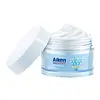What's inside
What's inside
 Key Ingredients
Key Ingredients

 Benefits
Benefits

 Concerns
Concerns

No concerns
 Ingredients Side-by-side
Ingredients Side-by-side

Water
Skin ConditioningNiacinamide
SmoothingGlycerin
HumectantBetaine
HumectantButylene Glycol
HumectantBiosaccharide Gum-1
HumectantDimethicone
EmollientCyclopentasiloxane
EmollientCarbomer
Emulsion StabilisingCyclohexasiloxane
EmollientBisabolol
MaskingAminomethyl Propanol
BufferingSodium Polyacrylate
AbsorbentXanthan Gum
EmulsifyingDisodium EDTA
Sodium Hyaluronate
HumectantDiethylhexyl Syringylidenemalonate
Skin ProtectingTrideceth-6
EmulsifyingPEG/PPG-18/18 Dimethicone
EmulsifyingAlpha-Glucan Oligosaccharide
CleansingCaprylic/Capric Triglyceride
MaskingPolymnia Sonchifolia Root Juice
Skin ConditioningMaltodextrin
AbsorbentAspergillus Ferment
Skin ConditioningZingiber Officinale Root Extract
MaskingLactobacillus
Skin ConditioningPhenoxyethanol
PreservativeChlorphenesin
AntimicrobialWater, Niacinamide, Glycerin, Betaine, Butylene Glycol, Biosaccharide Gum-1, Dimethicone, Cyclopentasiloxane, Carbomer, Cyclohexasiloxane, Bisabolol, Aminomethyl Propanol, Sodium Polyacrylate, Xanthan Gum, Disodium EDTA, Sodium Hyaluronate, Diethylhexyl Syringylidenemalonate, Trideceth-6, PEG/PPG-18/18 Dimethicone, Alpha-Glucan Oligosaccharide, Caprylic/Capric Triglyceride, Polymnia Sonchifolia Root Juice, Maltodextrin, Aspergillus Ferment, Zingiber Officinale Root Extract, Lactobacillus, Phenoxyethanol, Chlorphenesin
Water
Skin ConditioningCaprylic/Capric Triglyceride
MaskingGlycerin
HumectantPolyglyceryl-3 Methylglucose Distearate
EmulsifyingPropanediol
SolventStearyl Alcohol
EmollientSodium Acrylate/Sodium Acryloyldimethyl Taurate Copolymer
Emulsion StabilisingStearic Acid
CleansingPanthenol
Skin ConditioningSodium Benzoate
MaskingDicaprylyl Ether
EmollientSorbitol
HumectantC15-19 Alkane
SolventPolyglyceryl-6 Laurate
EmulsifyingAllantoin
Skin ConditioningBisabolol
MaskingCitric Acid
BufferingPolyglycerin-6
HumectantTocopheryl Acetate
AntioxidantWater, Caprylic/Capric Triglyceride, Glycerin, Polyglyceryl-3 Methylglucose Distearate, Propanediol, Stearyl Alcohol, Sodium Acrylate/Sodium Acryloyldimethyl Taurate Copolymer, Stearic Acid, Panthenol, Sodium Benzoate, Dicaprylyl Ether, Sorbitol, C15-19 Alkane, Polyglyceryl-6 Laurate, Allantoin, Bisabolol, Citric Acid, Polyglycerin-6, Tocopheryl Acetate
 Reviews
Reviews

Ingredients Explained
These ingredients are found in both products.
Ingredients higher up in an ingredient list are typically present in a larger amount.
Bisabolol is famous for its skin soothing properties. It does this by blocking inflammatory signals, helping to reduce your body's reaction to irritation.
This ingredient also interferes with the process of hyperpigmentation. This can help with reducing dark spots and uneven tone.
Bisabolol is an antioxidant. Antioxidants help fight free-radicals. Free-radicals are molecules that may damage your skin cells. By fighting these free-radicals, Bisabolol may slow down signs of aging.
Studies have shown Bisabolol to have antimicrobial properties and may be a fungicide. These properties help preserve a product's shelf life.
All these properties makes bisabolol a great skin barrier helper ingredient.
Bisabolol also helps the absorption of other ingredients.
Note: Synthetic Bisabolol has been shown to be less effective.
Learn more about BisabololThis ingredient is an emollient, solvent, and texture enhancer. It is considered a skin-softener by helping the skin prevent moisture loss.
It helps thicken a product's formula and makes it easier to spread by dissolving clumping compounds.
Caprylic Triglyceride is made by combining glycerin with coconut oil, forming a clear liquid.
While there is an assumption Caprylic Triglyceride can clog pores due to it being derived from coconut oil, there is no research supporting this.
Learn more about Caprylic/Capric TriglycerideGlycerin is already naturally found in your skin. It helps moisturize and protect your skin.
A study from 2016 found glycerin to be more effective as a humectant than AHAs and hyaluronic acid.
As a humectant, it helps the skin stay hydrated by pulling moisture to your skin. The low molecular weight of glycerin allows it to pull moisture into the deeper layers of your skin.
Hydrated skin improves your skin barrier; Your skin barrier helps protect against irritants and bacteria.
Glycerin has also been found to have antimicrobial and antiviral properties. Due to these properties, glycerin is often used in wound and burn treatments.
In cosmetics, glycerin is usually derived from plants such as soybean or palm. However, it can also be sourced from animals, such as tallow or animal fat.
This ingredient is organic, colorless, odorless, and non-toxic.
Glycerin is the name for this ingredient in American English. British English uses Glycerol/Glycerine.
Learn more about GlycerinWater. It's the most common cosmetic ingredient of all. You'll usually see it at the top of ingredient lists, meaning that it makes up the largest part of the product.
So why is it so popular? Water most often acts as a solvent - this means that it helps dissolve other ingredients into the formulation.
You'll also recognize water as that liquid we all need to stay alive. If you see this, drink a glass of water. Stay hydrated!
Learn more about Water